The short answer is: Yes, many 12V water pumps are specifically designed for continuous duty, but it is not a universal feature. Whether your pump can handle non-stop operation depends on its type, build quality, and operating conditions. Understanding these factors is crucial to prevent burnout and ensure longevity.
This guide will break down everything you need to know about running a 12V DC water pump.
1. Pump Type: The Biggest Factor
Not all 12V pumps are created equal. Their design dictates their duty cycle.
-
Diaphragm Pumps: These are often not designed for true 100% continuous duty. They are typically rated for intermittent use (e.g., 15 minutes on, 5 minutes off). Running a standard diaphragm pump continuously can lead to overheating and premature diaphragm failure due to the constant friction and pressure.
-
Exception: High-quality, industrial-grade diaphragm pumps with advanced cooling and durable materials can be run continuously.
-
-
Centrifugal Pumps: These are much better suited for continuous operation. They have a simpler design with an impeller and fewer moving parts. The fluid flowing through them often helps cool the motor. Many 12V centrifugal pumps are explicitly marketed as "continuous duty" for applications like water circulation in solar showers, RVs, or boats.
-
Brushless DC (BLDC) Pumps: These represent the gold standard for continuous use. They are highly efficient, generate less heat, have no brushes to wear out, and are often designed for 24/7 applications in medical devices, aquaculture, and precision equipment.
2. Key Factors for Successful Continuous Operation
Even if a pump is rated for continuous duty, several conditions must be met:
-
Adequate Cooling: The pump motor must not overheat. Centrifugal pumps rely on the water flowing through them for cooling. If the flow is restricted or the pump runs dry, it will overheat and fail quickly, even if it's a continuous-duty model.
-
Proper Power Supply: The pump must receive a stable, clean 12V power source. Voltage that is too low (causing the motor to stall) or too high (causing it to overheat) will damage the pump. Ensure your wiring, connectors, and power source (battery, solar panel, adapter) can handle the pump's continuous current draw (Amps).
-
Correct Operating Environment: A pump will run cooler and last longer in a well-ventilated, cool ambient environment compared to a hot, enclosed space.
-
Quality of Construction: Pumps with sealed bearings, corrosion-resistant materials, and quality motor windings are built to last under continuous stress. A cheap, poorly made pump will fail regardless of its stated duty cycle.
3. How to Tell If YOUR 12V Pump Can Run Continuously
-
Check the Data Sheet or Product Description: This is the most important step. Look for keywords like:
-
"Continuous Duty"
-
"100% Duty Cycle"
-
"Suitable for 24/7 Operation"
-
Conversely, be wary of "Intermittent Duty" or specified run/rest cycles.
-
-
Monitor Temperature: When you first install the pump, let it run for an hour and carefully feel the motor housing. It will be warm, but if it is too hot to touch comfortably, it is likely overheating and not suitable for long-term use.
-
Listen for Noise: A pump that is straining or overheating may make unusual noises—grinding, buzzing, or a change in pitch. This is a sign of impending failure.
4. Applications for Continuous Duty 12V Pumps
-
Water Circulation: In RVs, boats, off-grid systems, or tiny homes.
-
Aquaponics & Hydroponics: Constantly moving nutrient-rich water to plants.
-
Aquarium Sumps & Reef Tanks: Moving water through filtration systems.
-
Solar Heating Loops: Circulating water through solar panels to a storage tank.
-
Cooling Systems: For electronics or small engines.
5. Tips for Protecting Your Pump
-
Never Let It Run Dry: Running dry is the fastest way to destroy a water pump. Use a dry-run protection sensor or ensure the water source never runs out.
-
Use a Pre-Filter: For diaphragm pumps, a filter on the inlet prevents debris from clogging the valves and causing strain.
-
Ensure Proper Voltage: Use a correctly sized battery and thick enough wires to prevent voltage drop.
Conclusion:
While many robust 12V centrifugal and brushless DC pumps are perfectly capable of running continuously, you should never assume this is the case. Always verify the pump’s duty cycle in its specifications, provide a stable power source, and ensure it is cooled by a steady flow of water. Investing in a quality pump designed for continuous duty is essential for reliable, worry-free operation.
you like also all
Read More News
Post time: Sep-09-2025




